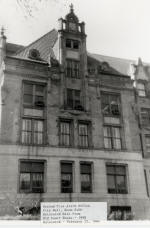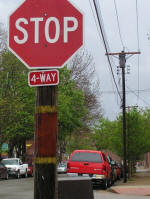|
|
The original office that received the alarms would eventually relocate in 1900, when it was moved to the fourth floor of City Hall, which at that time was a new building. Pictured to the left. In the early 1900's it was recommended for faster identification of alarm box locations, the street gas lights near fire alarms be provided with red domes, rather than the standard black. While this never happened, purple bands did replace the clear glass bands that had the street names etched into them around the top of these lights, near fire alarm boxes. |
|
According to the Fire and Police Patrol Census of 1912, St. Louis had a fire and a separate police system in place, with a total of 1,433 telegraphic boxes and 571 telephone boxes. False alarms were a problem in every city that had alarm boxes. In 1932 it was reported that the City of St. Louis received 12.4 false alarms per week. Most turned in by children on a dare. Still around in the 1950's, when most people still did not have phones, 47 people work in the Fire and Police telegraph section. |
|

|
In 1964, the Alarm center headquarters moved again to a location at 4971 Oakland Ave. |
|
According to Fire Chief Neil Svetanics, Even though the average time for a telegraph signal to be sent was only 15 to 20 seconds, versus 60 seconds for a telephone, with the introduction of the 9-1-1 system, the city began removing the Fire Box Alarm System. This was mainly due to the high number of false alarms. Effective January 1, 1977 the "Gamewell" system was discontinued. All alarms were struck over the audible and radio. The last boxes to be removed were the institutional boxes inside of public places such as, the Kiel Auditorium, hospitals, factories and theaters. This marked the end of an era that dates to the beginning of Fire alarm dispatching in St. Louis in 1858. |
|
 |
August 10, 1989 the city moves its Alarm Dispatching Center to 1421 North Jefferson. |




